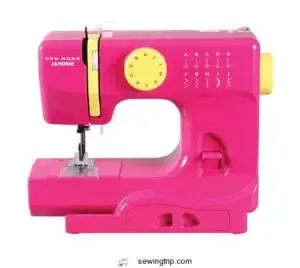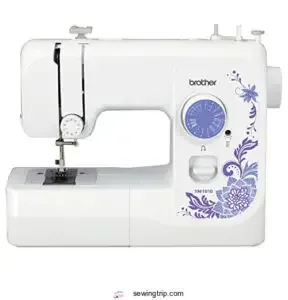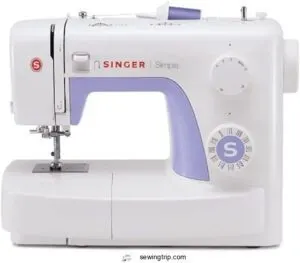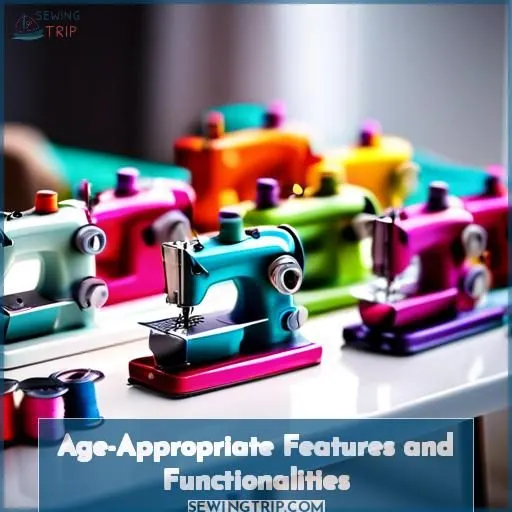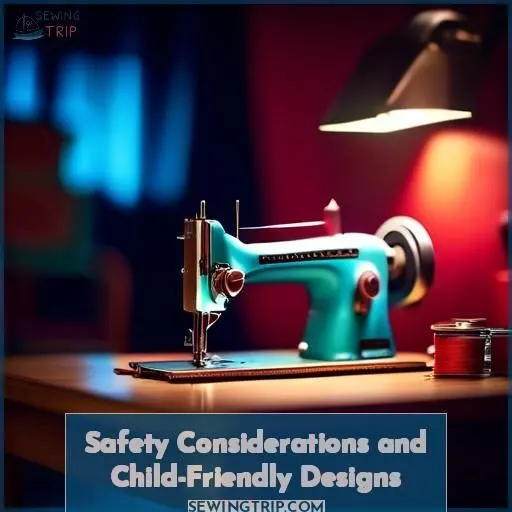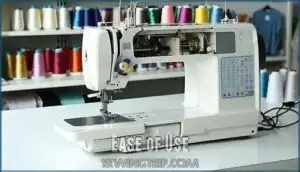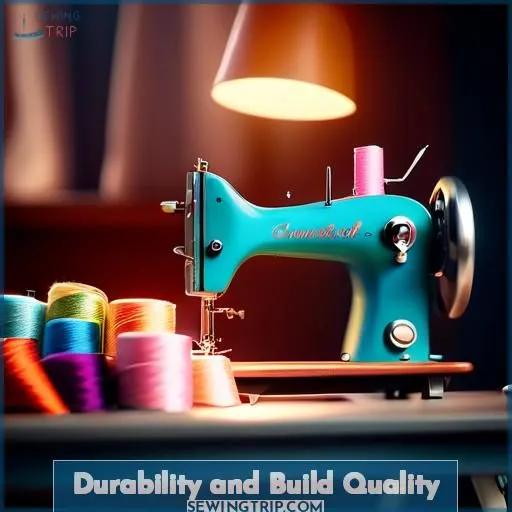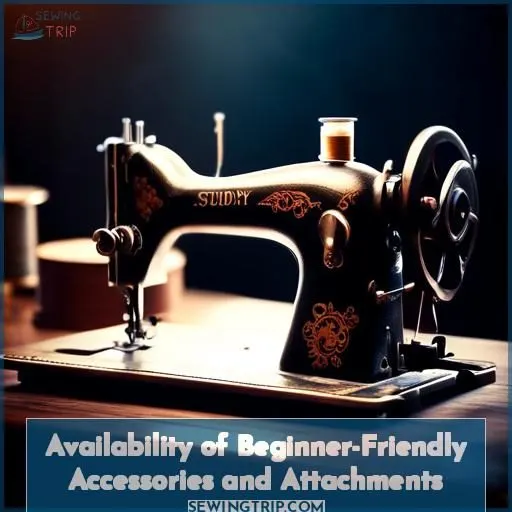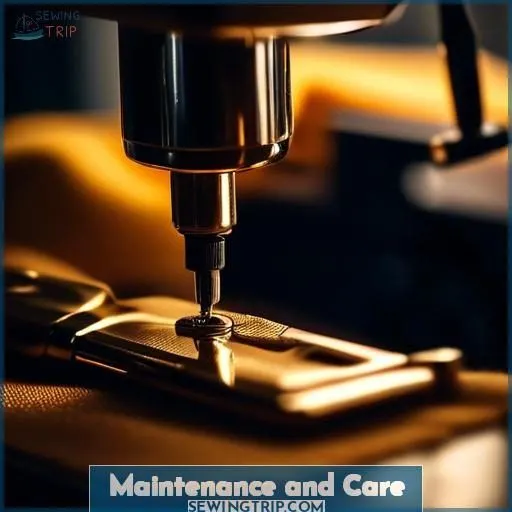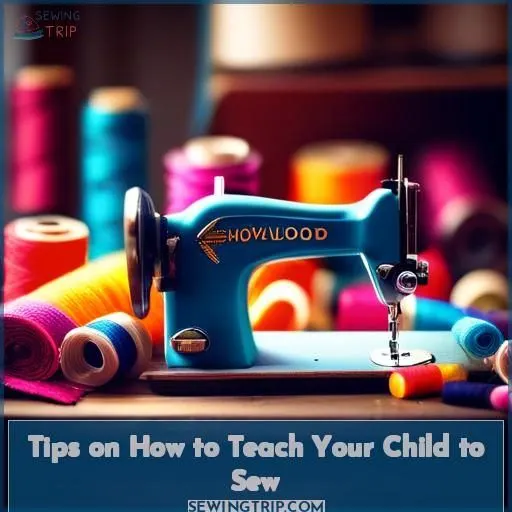This site is supported by our readers. We may earn a commission, at no cost to you, if you purchase through links.
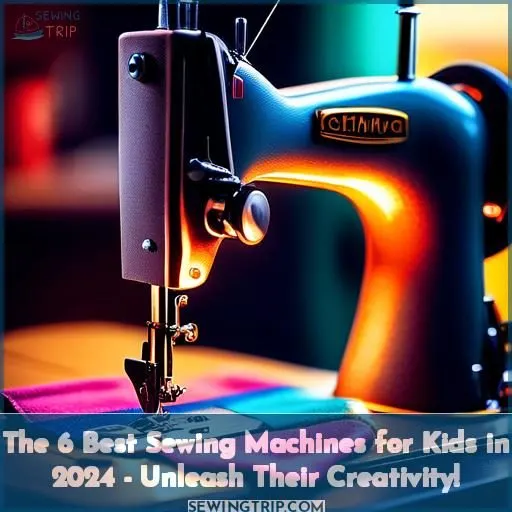
You’re seeking the optimal sewing machines for children that achieve a harmonious equilibrium between user-friendliness and functionality.
Prime choices such as the Janome Hello Kitty, Eversewn Sparrow 25, and Brother CS6000i feature compact dimensions, automatic needle threaders, integrated stitches, and free arm capabilities – ideally suited for diminutive hands.
Safety reigns supreme with attributes such as the absence of sharp edges, intuitive controls, and lucid threading guides.
Lightweight and portable constructions foster creativity wherever you venture.
However, to fully unlock your child’s sewing prowess, it’s prudent to investigate aspects like durability, ease of operation, and accessories designed for beginners.
Table Of Contents
- Key Takeaways
- Top 6 Best Sewing Machines for Kids
- Age-Appropriate Features and Functionalities
- Safety Considerations and Child-Friendly Designs
- Ease of Use
- Durability and Build Quality
- Availability of Beginner-Friendly Accessories and Attachments
- Maintenance and Care
- Tips on How to Teach Your Child to Sew
- Frequently Asked Questions (FAQs)
- Conclusion
Key Takeaways
- Safety and child-friendly design are paramount when selecting sewing machines for kids, emphasizing features like no sharp edges, intuitive controls, and clear threading guides.
- Durability and build quality are crucial, with a preference for machines that have metal parts, a solid weight for stability, and high-quality components to withstand regular use.
- Ease of use is essential for fostering a child’s sewing skills, including features like simple stitch selection, automatic needle threading, and speed control dials for hands-free sewing.
- Regular maintenance and care, including teaching children proper bobbin insertion and needle replacement, are important for ensuring the longevity and optimal performance of the sewing machine.
Top 6 Best Sewing Machines for Kids
Are you prepared to ignite your child’s imagination with the most suitable sewing machines for children? From the conveniently sized and beginner-friendly Janome Hello Kitty to the sturdy and feature-rich Eversewn Sparrow 25, we present the top 6 choices that will make sewing a piece of cake for your young ones.
1. Janome 3/4 Size Hello Kitty Sewing Machine
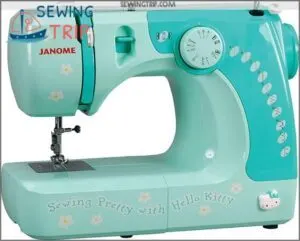 View On Amazon
View On Amazon
The Janome 3/4 size Hello Kitty Sewing Machine is a great choice for kids and beginners. It’s compact, lightweight, and easy to handle, making it perfect for young sewers. Here are some key features of this machine:
- Size: This machine is 3/4 the size of a standard sewing machine, which makes it more manageable for children and those with smaller workspaces.
- Stitches: The Janome 11706 comes with 11 built-in stitches, including a 4-step buttonhole, which is ideal for beginners and quilting projects.
- Heavy Duty: Despite its small size, this machine is capable of heavy-duty sewing, making it suitable for a wide range of projects.
- Accessory Storage: The machine features accessory storage compartments, which is convenient for keeping sewing supplies organized.
- Free Arm: The free arm capability allows for easier sewing on curved or circular items.
- Portability: Weighing just 10 pounds, this machine is light enough to carry around for classes or for those who need a portable sewing solution.
The Janome 11706 Hello Kitty Sewing Machine is a fully functioning and quality built sewing machine, not a toy, and is ideal for users of all ages and skill levels. It’s a great way to introduce kids to sewing in a fun and engaging way.
Best For: Beginners, quilters, and those with limited space
- Compact and lightweight for easy maneuverability
- 11 stitches, including a 4-step buttonhole, for versatility
- Heavy-duty sewing capability for a wide range of projects
- Bobbin winding can be tricky
- Maneuvering the bobbin into place can be difficult
- Speed is slightly slower than a full-sized machine
2. Eversewn Sparrow 25 Sewing Machine
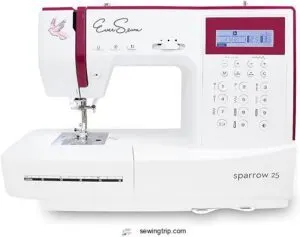
The Eversewn Sparrow 25 is a computer-controlled sewing machine that offers a wide range of features for both sewing and quilting. It boasts 197 stitch patterns, including 1 alphabet, 7 buttonholes, and 1 eyelet stitch. Decorative stitches can be set up to a width of 7 mm or as desired. The machine features a slide speed control, start/stop function, and needle stop up/down. It also includes a bright sewing light and seven presser feet (soles) standard with this model.
One of the key benefits of the Eversewn Sparrow 25 is its memory function, which allows individual stitch combinations to be saved. This is particularly useful for quilters who may want to save specific stitch patterns for different projects. The machine also features a 6-inch throat space, which provides ample room for sewing larger projects.
The Eversewn Sparrow 25 is priced at $325 and weighs approximately 13.5 lbs. It has a 6.5-inch throat space and measures 16.5”W x 7”D x 12.5”H. The machine is available in a variety of colors, including white and blush.
One user who purchased the Eversewn Sparrow 25 reported that the machine has exceeded their expectations. They noted that it has solid construction and makes nice stitches. Another user compared the performance of the EverSewn Sparrow 25 to that of a Janome 7700, stating that there isn’t a significant difference between the two machines in terms of stitching quality.
Best For: Quilters and sewers who want a versatile machine with advanced features.
- Wide variety of stitch patterns (197)
- Memory function for saving stitch combinations
- Ample throat space (6 inches)
- Lacks automatic thread cutter
- May require additional accessory feet for quilting
- Freight intensive, potentially incurring additional shipping charges
3. Brother Cs6000i Sewing And Quilting Machine
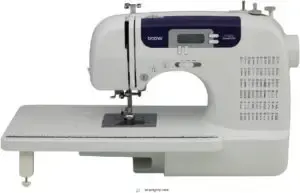
Imagine your little one’s face lighting up as they create their first masterpiece with the Brother CS6000i Sewing and Quilting Machine. It’s like giving them the keys to a creative kingdom!
This machine isn’t just kid-friendly with its easy-to-use features; it’s a trusty sidekick for any sewing adventure. With 60 built-in stitches and a jam-resistant drop-in bobbin, it’s a breeze to switch from superhero capes to cozy quilts.
The automatic needle threader? A real eye-saver, especially when you’re in the middle of a sewing marathon. And let’s not forget the wide table and hard protective case – talk about sewing on the go!
Plus, with a 25-year limited warranty, it’s like having a sewing guardian angel. Just remember, it’s designed for 120 volts, so it’s a no-go for globetrotting stitchers without the right power supply.
Best For: Beginners, quilters, and anyone looking for a versatile and user-friendly sewing machine.
- 60 built-in stitches for a wide range of projects
- Automatic needle threader for easy setup
- Drop-in top bobbin for quick and easy bobbin changes
- Not recommended for use in countries that do not support 120V AC
- Machine is lightweight and may move around on the table
- Throat space is not very large
4. Janome Fastlane Fuschia Portable Sewing Machine
The Janome Fastlane Fuschia Portable Sewing Machine is a great choice for kids and beginners. It’s a compact machine, weighing only 5 pounds, making it easy to transport for classes or sewing with friends.
With 10 built-in stitches, including straight, zigzag, crescent, and multi-stitch zigzag, this machine offers a variety of stitch options for different materials. The free arm feature allows for easier sewing, and the accessory storage and easy reverse make it versatile for various sewing projects.
The top drop-in bobbin with a clear cover simplifies setup, and the presser foot with a finger guard protects little fingers. However, it doesn’t come with a case or a handle, and some users have mentioned that it’s a little louder than other machines.
Despite these minor drawbacks, the Janome Fastlane Fuschia Portable Sewing Machine is a reliable and user-friendly option for kids and beginners.
Best For: Kids and beginners looking for a portable and easy-to-use sewing machine.
- Compact and lightweight
- Easy to thread and use
- Produces high-quality stitches
- Does not come with a case or a handle
- A little louder than some other machines
- Not suitable for full-featured sewing needs
5. Brother Sewing Machine XM1010 10 Built-in Stitches
The Brother XM1010 is a versatile sewing machine that offers 10 built-in stitches, including utility stitches, decorative stitches, and an auto-size buttonhole. This machine is designed for a wide range of sewing projects, from everyday mending to more advanced tasks like zipper insertion and applique. The XM1010 is also equipped with an automatic needle threader and a jam-resistant drop-in top bobbin, making it easy to set up and start sewing.
One of the key features of the Brother XM1010 is its compatibility with a variety of presser feet, including a zigzag foot, zipper foot, buttonhole foot, and button sewing foot. This allows users to tackle different sewing tasks with ease and precision. Additionally, the machine features a free arm for sewing cuffs and sleeves, which is particularly useful for garment sewing projects.
The XM1010 is also praised for its ease of use, with a turn-of-the-dial stitch selection system and a reverse sewing lever that gives users added control. The machine is lightweight and portable, making it ideal for those who want to take their sewing on the go.
Best For: Beginners and experienced sewists looking for an affordable and versatile machine for everyday sewing projects.
- Easy to use with automatic needle threading and jam-resistant bobbin
- Versatile with 10 built-in stitches and compatibility with various presser feet
- Portable and lightweight for easy storage and transport
- Short foot controller cord
- Some users experienced issues with thread tension and loud noises
- Not suitable for heavy-duty sewing projects
6. Singer Simple 3232 Sewing Machine
The Singer Simple 3232 Sewing Machine is a fantastic choice for kids who are just embarking on their sewing odyssey. With a maximum speed of 750 stitches-per-minute, it’s ideal for those who want to learn swiftly and proficiently.
The machine comes with a 1-step automatic needle threader, making it effortless for children to get started without any trouble. It also features a heavy-duty metal frame, ensuring longevity and steadfastness during use.
Plus, with built-in stitches for diverse materials and a high presser foot lifter, the Singer Simple 3232 Sewing Machine is adaptable enough to handle a wide spectrum of projects.
Overall, this machine is a great investment for parents looking to introduce their kids to the realm of sewing.
Best For: Kids who are just starting to sew.
- Maximum speed of 750 stitches-per-minute
- 1-step automatic needle threader
- Heavy-duty metal frame
- Not warranted for use outside of the US and Canada
- Only compatible with 110 volts
- No carrying case included
Age-Appropriate Features and Functionalities
When introducing kids to sewing, it’s essential to select a machine with features suited to their age. Consider a small size for convenient handling, automatic needle threading to reduce frustration, and built-in stitches appropriate for different materials, allowing their creativity to flourish.
Compact Size for Easy Handling
When it comes to sewing machines designed for children, it’s essential to prioritize a compact size for ease of use. Here are three key factors to keep in mind:
- Child-sized machines: Seek machines that are appropriately sized for children. These machines are often smaller and lighter, making them easier for kids to handle and carry.
- Colorful designs: Many child-friendly sewing machines are available in vibrant and cheerful colors, which can enhance the learning experience and make it more enjoyable for kids.
- Lightweight builds: Machines that are lightweight are easier for children to handle and control, minimizing the risk of injury or frustration.
Some popular options for child-sized sewing machines include the Brother XM1010, which offers 10 built-in stitches and is suitable for beginners. The Eversewn Sparrow 20 is another lightweight option, designed with a child-friendly interface and suitable for various sewing projects. The Simplicity Model SB700t by Brother is also a popular choice, renowned for its user-friendliness and portability.
Automatic Needle Threading
After mastering the compact size for easy handling, your little tailor can tackle the next challenge: threading. With an automatic needle threader, sewing machines for kids turn a tricky task into child’s play.
No more squinting or frustration over thread tension; just select your needle, dial in the stitch length, and the machine weaves its magic, making pattern selection and fabric compatibility a breeze.
Built-in Stitches for Various Materials
Built-in stitches are a game-changer for kids’ sewing machines. With a variety of stitch options, they can experiment with different materials and sewing applications.
The stitch variety guarantees fabric versatility, allowing kids to tackle various projects with ease. These stitches are compatible with a wide range of materials, enhancing the durability of their creations.
The sewing machine’s stitch applications empower kids to express their creativity and learn the art of sewing in a fun and engaging way.
Free Arm Capability for Easier Sewing
As a kid, sewing with a free arm capability can make the sewing process much easier and more enjoyable. With a free arm, you can sew curved seams, circular projects, and even attach sleeves without the fabric shifting or looking wobbly. Here are four reasons why a free arm sewing machine is beneficial for kids and teens:
- Easier Sewing: Free arm sewing machines allow you to guide the fabric under the needle more easily, making it less likely you’ll catch other parts of the garment accidentally.
- Curved Seams: Free arm sewing machines are perfect for sewing curved seams, which are common in clothing items like pants and sleeves.
- Hemming and Attaching Sleeves: Hemming sleeves and the bottom of pants is a breeze with a free arm sewing machine, as it makes it easier to guide the fabric under the needle.
- Small Items: Free arm sewing machines are great for sewing small items such as doll and baby clothes, as well as mending clothes like the knees on pants.
Lightweight and Portable
Regarding sewing machines for children, weight and portability are essential considerations. A lightweight machine simplifies handling for beginners, while portability facilitates storage and transportation to classes or workshops.
The ideal sewing machines for kids are lightweight and portable, ensuring ease of operation and improved usability. These devices are tailored for beginners, ensuring that they aren’t burdened by heavy or unwieldy equipment.
Safety Considerations and Child-Friendly Designs
When selecting a sewing machine for your child, prioritize safety and child-friendly design. Look for features like no sharp edges, easy-to-use controls, clear threading guides, accessible bobbin slots, and durable materials that will keep your little one protected and focused on their creative projects.
No Sharp Edges or Small Parts
Regarding sewing machines for kids, safety is of utmost importance. Seek models devoid of sharp edges or minuscule components that could present a hazard.
Controls tailored for children should be comprehensible and manageable, even for novices. Age-appropriate designs guarantee longevity and alignment with accessories suitable for beginners.
Safety aspects like transparent threading guides, readily accessible bobbin slots, and winding mechanisms are crucial. Opt for machines with robust metallic components and substantial weight for stability.
Easy-to-use Controls
Empower your child to explore their creativity with sewing machines that feature automatic bobbin insertion, extension tables, and a wide stitch variety.
Look for machines with threading guides and durable materials that guarantee a smooth sewing experience. A speed control dial allows for hands-free sewing, while an LCD display and 1-step buttonhole options simplify the process.
With easy bobbin loading, your child can focus on their project without frustration.
Clear Threading Guides
Clear threading guides are a user-friendly feature that simplifies the learning process for beginners. These guides help the user navigate the threading process, ensuring that the needle is properly threaded and reducing the likelihood of tangling or jamming.
Some sewing machines even have an automatic needle threader, which can be especially helpful for children learning to sew.
Additionally, some machines come with an instructional DVD or a beeping noise to alert the user if the presser foot isn’t lowered, preventing mistakes and ensuring a smooth sewing experience.
Accessible Bobbin Slots and Winding Mechanisms
Accessible bobbin slots and intuitive winding mechanisms are a must for kid-friendly sewing machines. No one wants a frustrated child struggling to load the bobbin – that’s a surefire way to kill their enthusiasm. Look for machines with clear bobbin compartments and simple, one-step winding processes. This enhances both safety and ease of use, keeping young sewers engaged and confident.
Durable Materials
When it comes to selecting a sewing machine for children, durability is a vital consideration. You want a machine that can endure the rigors of everyday use while also being safe and manageable for kids. Here are some key aspects to keep in mind:
- Materials: Seek machines with metallic components and a sturdy frame. Metallic parts are more robust and resistant to damage compared to plastic ones. A well-crafted machine can sew through various fabrics, including thick materials, without breaking down.
- Safety: Confirm that the machine has no sharp edges or small components that could pose a hazard to children. Some machines are equipped with finger guards to shield little fingers from injury.
- Ease of use: A child-friendly design should comprise easy-to-use controls and clear threading guides. Readily accessible bobbin slots and winding mechanisms are also important for minimizing frustration during setup and maintenance.
- Maintenance: Teach your child how to properly maintain their machine, such as removing lint and dust, inserting the bobbin, and replacing the needle at regular intervals. Covering the machine when it isn’t in use can also help protect it from damage.
- Durability and build quality: Consider brands renowned for their robust machines, like Bernina and Brother. These machines often have a reputation for longevity and reliability, which is essential for a child’s machine.
- Warranty or repair services: A comprehensive warranty or access to repair services can provide peace of mind and ensure the machine remains functional for years to come.
Ease of Use
When choosing a sewing machine for your child, ease of use is key. Look for features like pedal or push-button operation, simple stitch selection, and a speed control dial to make sewing a breeze for beginners.
Pedal or Push-button Operation
Key aspect to think about when selecting a sewing machine for kids is the type of operation: pedal or push-button. It impacts ease of use and safety.
For those just starting out, a push-button machine is more suitable and safer. Conversely, a pedal-operated machine provides more control and is ideal for older children.
A pedal is also more practical for working on larger projects. Take into account your child’s age and abilities when making a decision on the type of operation.
Simple Stitch Selection
As a child, the thought of selecting the appropriate stitch for your project can be overwhelming. However, with these sewing machines, you’ll discover user-friendly stitch selection that caters to children. Seek machines that have bobbins designed for children, a spacious sewing base, minimal noise, and a vibrant appearance.
The Brother XL2600i and Brother CS6000i are excellent choices, providing frustration-free stitch selection.
The Janome Magnolia’s ample base and considerable weight also contribute to its ease of use.
Easy Threading and Bobbin Loading
Eliminate the frustration and embark on sewing with effortless threading and bobbin loading.
Picture the Singer 3232, Janome Hello Kitty, and Husqvarna Viking Emerald machines as your steadfast companions, providing explicit instructions for a swift setup.
It’s analogous to having a navigational aid for your sewing adventure—no further entanglements in thread tangles.
Bid farewell to setup challenges and embrace uninterrupted creativity!
Speed Control Dial for Hands-free Sewing
Speed control dials allow for hands-free sewing, ensuring your child can focus on their project without worrying about the machine’s speed. This feature is particularly useful when using a drop feed or for free motion sewing.
With just a turn of the dial, they can adjust the speed to their comfort level. Remember, not all machines come with this feature, so it’s important to verify before purchasing.
Some vintage sewing machines may not have this option, so explore modern models for a more seamless experience.
User-friendly for Beginners
As a beginner, you’ll appreciate sewing machines with features designed for children.
Look for clear instructions and projects that are suitable for your age.
Safety is paramount, so machines with smooth edges and no small parts are highly recommended.
Developing your skills is essential, so machines that allow for fast sewing and easy-to-use controls are crucial.
For stitch options, consider machines with a range of basic stitches and decorative crafts.
Finally, user-friendly machines should be beginner-friendly, with straightforward stitch selection and simple threading and bobbin loading.
Durability and Build Quality
Durability and build quality should be top priorities when selecting a sewing machine for your child.
Look for machines with metal parts for sturdiness, a solid weight for stability, and high-quality components that can withstand regular use.
Additionally, consider models from reputable brands that offer warranty or repair services.
This ensures your investment is protected and your child can enjoy their sewing adventures without disruptions.
Metal Parts for Sturdiness
In selecting a sewing machine for children, robustness and build quality are paramount considerations. Metallic components play a pivotal role in guaranteeing sturdiness and dependable performance. Here are five key aspects to prioritize when seeking a sewing machine with metal parts:
- Metallic Internal Framework: A metallic internal framework provides stability and minimizes the likelihood of missed stitches. It also ensures the machine operates steadily, eliminating vibrations that could impair stitch quality.
- Metallic Internals: Machines featuring metallic internals, including gears and motors, are more robust and less susceptible to wear and tear. They can handle denser fabrics and multiple layers without compromising performance.
- Resilient Materials: Metallic components are typically more resistant to damage than plastic components. They can endure the rigors of daily use and are less prone to breakage or premature wear.
- Thick Layers of Fabric: Metallic components can handle thicker layers of fabric without bending or breaking. This is particularly crucial for children who may work with diverse materials and fabric thicknesses.
- Premium Components: Machines with high-quality metallic components tend to have a longer lifespan and perform better over time. They can handle heavier fabrics and multiple layers effortlessly, ensuring a long-lasting build.
Solid Weight for Stability
The weight of a sewing machine plays a vital role in its stability and sturdiness.
A machine with significant weight can handle various materials and sewing techniques without wobbling or tipping over.
This is particularly important for children, who may not have the strength or experience to control a lightweight machine.
Look for sewing machines with metal parts and substantial weight, as these will provide the necessary stability for a child’s sewing projects.
High-quality Components
Sewing machines for kids should be built to endure. Top-notch components are key for sturdiness and build quality. Seek out machines with metallic parts, hefty weight, and robust materials. Multiple manufacturers provide guarantee services to give comfort. By purchasing a well-constructed machine, you’re equipping your child with a tool that can evolve with them and manage diverse sewing endeavors.
Warranty or Repair Services Available
When selecting a sewing machine for your child, warranty particulars and repair choices are pivotal factors to contemplate. A sewing machine with a dependable warranty and readily available repair services contributes to its endurance and construction quality. Here’s a table summarizing the warranty and repair choices for some sought-after sewing machines:
| Sewing Machine | Warranty Particulars | Repair Choices |
|---|---|---|
| Brother XM1010 | 25-year limited warranty (USA only) | Contact Brother Authorized Service Center or visit their website for repair services |
| Janome Hello Kitty | 5-year limited warranty | Contact Janome America for warranty and repair information |
| Janome Fastlane Fuschia | 25-year limited warranty | Contact the authorized Janome dealer or a Janome Authorized Service Center for repair services |
| Eversewn Sparrow | Contact Eversewn for warranty and repair information | Call Eversewn for assistance with warranty issues |
Customer feedback is also vital when appraising the reliability of a sewing machine. For instance, the Brother XM1010 has garnered mixed reviews, with some users lauding its stitch quality and durability, while others have reported difficulties with the machine’s strength and user-friendliness.
Additionally, ponder the availability of accessories for your chosen sewing machine. Some machines come with a variety of included accessories, such as needles, bobbins, and presser feet, which can be advantageous for beginners.
Lastly, it’s imperative to educate your child on how to maintain their sewing machine, including regular cleaning to thwart dust and lint buildup, proper bobbin insertion, and needle replacement.
Availability of Beginner-Friendly Accessories and Attachments
When considering sewing machines for kids, pay close attention to the included accessories and attachments. Most beginner-friendly models come with essential extras like needles, bobbins, and presser feet to get started, and many are compatible with standard sewing machine accessories for future expansion.
Included Accessories Such as Needles, Bobbins, and Presser Feet
When you’re diving into the sewing world, the right tools can make all the difference. Here’s what to look for in included accessories:
- Bobbin sizes that match your projects, ensuring smooth sailing through fabric layers.
- A variety of presser feet types for every stitch and style.
- Fabric compatibility tools that cater to your creative whims.
- Accessories that promise stitch quality that’s exceptional, making every project a masterpiece.
Compatibility With Standard Sewing Machine Accessories
Selecting a sewing machine compatible with standard accessories is like discovering a key that opens limitless creative avenues. Compatibility is paramount—ensuring presser feet, bobbin winding, and needle insertion are effortless. This grants you not only control but also liberates you to navigate the expansive ocean of sewing possibilities without becoming entangled in complexities.
| Feature | Importance | Why It Rocks |
|---|---|---|
| Presser Feet | High | Swap with ease, varied designs |
| Bobbin Winding | Medium | Smooth sailing commences |
| Needle Insertion | Essential | No punctures, only clicks |
Maintenance and Care
Regular care is essential for maintaining your child’s sewing machine in optimal condition. Regularly clean the machine to prevent accumulation of dust and fibers, and educate your child on the proper insertion of the bobbin and replacement of the needle. These fundamental tasks will guarantee seamless operation and prevent disappointment.
Regular Cleaning to Prevent Dust and Lint Buildup
Regular cleaning is essential to prevent dust and lint buildup in your child’s sewing machine. Here’s how to maintain your machine:
- Bobbin Winding: Wind a new bobbin before starting a new project.
- Needle Replacement: Replace the needle frequently to guarantee smooth sewing.
- Dust Control: Clean the exterior with a soft brush or cloth.
- Lint Removal: Remove lint from the bobbin case and under the presser foot.
- Maintenance Routine: Establish a routine to keep the machine in prime condition.
Teaching Children Proper Bobbin Insertion and Needle Replacement
Bobbin winding and needle threading are vital tasks for fruitful sewing projects. Appropriate guidance and practice are imperative for children to acquire these skills safely and effectively. Here are some hints for teaching children how to insert a bobbin and thread a needle:
- Bobbin Insertion: Initiate by elucidating the significance of a replete bobbin for seamless sewing. Demonstrate how to insert a new bobbin into the bobbin case, guaranteeing it’s firmly in place. Show them how to wind the bobbin with the appropriate thread, utilizing the bobbin winder or a hand-cranked method. Emphasize the importance of maintaining the thread tension even and consistent.
- Needle Threading: Instruct children how to thread a needle using a needle threader or a safety eye. Explain the importance of threading the needle from the back to the front, then from the front to the back. Demonstrate how to tie a knot at the terminus of the thread, ensuring it’s securely attached to the needle.
- Fabric Selection: Encourage children to select the appropriate fabric for their project, considering factors such as fabric type, thickness, and texture. Teach them how to cut fabric accurately, using a rotary cutter or scissors, and how to press seams properly with an iron.
- Project Ideas: Provide children with a variety of project ideas, such as simple sewing projects, quilts, or clothing items. Encourage them to experiment with different stitch applications, such as straight, zigzag, or decorative stitches.
- Safety Precautions: Reinforce the importance of safety when sewing, such as wearing closed-toe shoes, avoiding loose clothing, and keeping hands away from moving parts. Encourage children to seek assistance when needed and to take breaks when feeling tired or overwhelmed.
Tips on How to Teach Your Child to Sew
When teaching your child to sew, start early with age-appropriate machines and materials that foster creativity and problem-solving skills. Provide hands-on guidance, let them choose their fabrics and projects, and encourage regular practice – this improves skills, builds confidence, and sets free their creativity.
Starting Early With Age-appropriate Machines and Materials
Beginning early with suitable equipment and supplies is essential for teaching children to sew effectively. Regarding sewing machines for children, it’s imperative to select models that are secure, user-friendly, and appropriate for their age and skill level. Here are some guidelines for choosing the ideal sewing machine for your child:
- Age-suitable: Consider your child’s age and ability to operate the machine. Seek machines with features tailored for young learners, such as a lightweight design, user-friendly controls, and stitch options suitable for their skill level.
- Child-safe: Select machines with safety features like finger guards, low-speed settings, and stable construction to guarantee your child’s safety while learning to sew.
- User-friendly: Choose machines with intuitive controls, clear threading guides, and accessible bobbin slots and winding mechanisms to reduce frustration and facilitate learning.
- Durable: Opt for machines with high-quality components and a warranty or repair services to ensure the machine can withstand the wear and tear of regular use.
- Beginner-friendly accessories: Look for machines that come with essential sewing supplies, such as needles, bobbins, and presser feet, to assist your child in getting started.
- Compatibility with standard accessories: Ensure the machine is compatible with standard sewing machine accessories, so your child can expand their skills and creativity as they progress.
Encouraging Creativity and Problem-solving Skills
Foster your child’s imagination and problem-solving abilities by granting them the freedom to explore various stitches, fabrics, and sewing methods.
Allow them to let their imaginations soar and create distinctive projects.
Inspire them to analyze their work systematically, resolve difficulties, and develop solutions.
This won’t just enhance their motor capabilities but also boost their self-assurance and instill a sense of fulfillment.
Providing Hands-on Guidance and Support
Diving into sewing with your child isn’t just about threading needles; it’s about weaving stronger parent-child bonds. Imagine the laughter and high-fives with every straight stitch mastered. It’s sibling collaboration at its finest and a teacher-student interaction that’s genuinely fun. Encourage peer support and watch as their creative expression blossoms. This journey is more than sewing; it’s about growing together.
Allowing Children to Choose Their Own Fabrics and Projects
Enabling children to select their preferred fabrics and projects can substantially augment their sewing journey. Here are four approaches to foster their imagination and self-expression:
- Fabric Selection: Present an array of fabrics, ranging from cotton to velvet, and permit them to choose their most beloved.
- Project Choice: Provide a spectrum of straightforward projects, including pillows or tote bags, and allow them to determine which one they desire to create.
- Personal Style: Encourage them to manifest their individual style by selecting fabrics and patterns that mirror their personality.
- Customization: Impart knowledge on how to personalize their projects with embellishments or monograms, empowering them to incorporate a personal touch.
Practicing Regularly to Improve Skills and Confidence
Regular practice is indispensable for skill development and confidence building. Motivate your child to sew on diverse materials and attempt various projects. Provide innovative inspiration through project suggestions and problem-solving challenges. Acknowledge their accomplishments, regardless of their scope, to enhance their confidence. Bear in mind, practice leads to proficiency!
Frequently Asked Questions (FAQs)
What are the best sewing machines for kids?
You’ll want a machine that’s durable, portable, and beginner-friendly. Go for a lightweight model with basic stitches, easy threading, and speed control. Brands like Janome, Brother, and Eversewn offer great kid-friendly options that won’t break the bank.
What factors should be considered when choosing a sewing machine for kids?
Did you know 85% of kids excel with hands-on projects? When choosing a sewing machine, consider age-appropriate features, safety, durability, and ease of use. Let their creativity soar – it’ll develop lifelong skills!
What are the safety considerations for sewing machines for kids?
When choosing sewing machines for kids, look for safety features like finger guards, automatic thread cutters, and low voltage. Also, supervise young ones closely as needles can be sharp.
What are the best beginner-friendly accessories and attachments for sewing machines for kids?
You’ll want presser feet for basic stitches, a gathering foot for gathering fabric easily, and an overlock foot for neatly finishing seams – all simple tools that’ll enable your kid’s sewing success from day one.
How should sewing machines for kids be maintained and cared for?
Maintaining a kid’s sewing machine is easy—regularly remove lint buildup, check needle condition, lubricate moving parts per instructions, and cover when not in use. Teaching proper care and maintenance instills responsibility and appreciation.
Conclusion
Igniting your child’s creativity with the most suitable sewing machines for kids is akin to kindling a passion that will endure.
These user-friendly marvels, designed specifically for young hands, cultivate independence and skills that go beyond simply sewing.
With well-thought-out features, sturdy construction, and beginner-friendly accessories, you’re empowering your little one to transform dreams into reality – stitch by stitch.
Embrace this journey, for it’s more than sewing; it’s nourishing limitless imagination.

